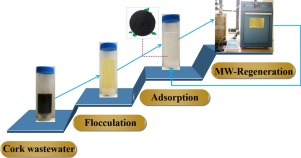Journal of Hazardous Materials ( IF 12.2 ) Pub Date : 2018-08-16 , DOI: 10.1016/j.jhazmat.2018.08.022 Xinyu Ge , Zhilin Wu , Giancarlo Cravotto , Maela Manzoli , Pedro Cintas , Zhansheng Wu

|
The aim of this work is to investigate a novel cork wastewater (CW) purification method that combines flocculation/adsorption with the microwave assisted regeneration of coconut powder activated carbon (CPAC). The flocculation treatment made use of FeSO4·7H2O/NaOH and provided high removal efficiency, as shown by the observed values of UV254 (90%), chemical oxygen demand (COD, 86%), polyphenols (PP, 81%),total solid (TS, 40%), total suspended solid (TSS, 62%), and total dissolved solid (TDS, 18%). After the flocculation and filtration, CPAC was used to further remove left TSS, TDS and dissolved organics. The effects of CPAC amount, pH value and adsorption time have been studied. It was found that 250 mg is the optimum CPAC amount for the treatment of 50 mL CW at pH 3.5 for 10 min. Overall process effectiveness can be summarised as follows: UV254 (100%), COD (98%), PP (100%), TS (58%), TSS (93%), and TDS (24%), while the characteristic colour of the CW completely disappeared. The microwave regenerated CPAC can undergo five runs without appreciable losses in removal efficiency. Predictably, this simple and scalable process could afford a promising treatment method for other industrial wastewaters with high content of organic matters such as PP, phenolic acids and tannins.
中文翻译:

微波再生活性炭协同絮凝/吸附过程中的软木废水净化
这项工作的目的是研究一种新颖的软木废水(CW)净化方法,该方法将絮凝/吸附与微波辅助再生椰子粉活性炭(CPAC)结合在一起。如Fe 254的观测值所示,使用FeSO 4 ·7H 2 O / NaOH进行的絮凝处理具有很高的去除效率。(90%),化学需氧量(COD,86%),多酚(PP,81%),总固体(TS,40%),总悬浮固体(TSS,62%)和总溶解固体(TDS,18 %)。絮凝和过滤后,使用CPAC进一步去除残留的TSS,TDS和溶解的有机物。研究了CPAC用量,pH值和吸附时间的影响。发现250 mg是在pH 3.5的条件下处理50 mL CW 10分钟的最佳CPAC量。总体过程有效性可以归纳如下:UV 254(100%),COD(98%),PP(100%),TS(58%),TSS(93%)和TDS(24%),而CW的特征色则完全消失了。微波再生的CPAC可以进行五次运行,去除效率没有明显损失。可以预见的是,这种简单且可扩展的方法可以为有机物含量较高的其他工业废水(如PP,酚酸和单宁酸)提供一种有前途的处理方法。











































 京公网安备 11010802027423号
京公网安备 11010802027423号